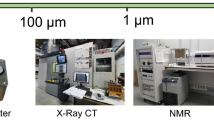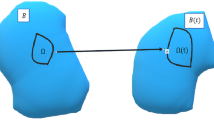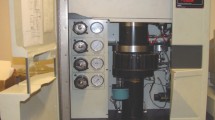Abstract
The paper presents a comprehensive, newly developed software–poROSE (poROus materials examination SoftwarE) for the qualitative and quantitative assessment of porous materials and analysis methodologies developed by the authors as a solution for emerging challenges. A low porosity rock sample was analyzed and thanks to the developed and implemented methodologies in poROSE software, the main geometrical properties were calculated. A tool was also used in preprocessing part of the computational analysis to prepare a geometrical representation of the porous material. The basic functions as elimination of blind pores in the geometrical model were completed and the geometrical model was exported for CFD software. As a result, it was possible to carry out calculations of the basic properties of the analyzed porous material sample. The developed tool allows to carry out quantitative and qualitative analysis to determine the most important properties characterized porous materials. In presented tool the input data can be images from X-ray computed tomography (CT), scanning electron microscope (SEM) or focused ion beam with scanning electron microscope (FIB-SEM) in grey level. A geometric model developed in the proper format can be used as an input to modeling mass, momentum and heat transfer, as well as, in strength or thermo-strength analysis of any porous materials. In this example, thermal analysis was carried out on the skeleton of rock sample. Moreover, thermal conductivity was estimated using empirical equations.
Similar content being viewed by others

References
Krakowska P, Puskarczyk E, Jędrychowski M, Habrat M, Madejski P and Dohnalik M. Innovative characterization of tight sandstones from Paleozoic basins in Poland using X-ray computed tomography supported by nuclear magnetic resonance and mercury porosimetry. Journal Petroleum Science and Engineering, 2018, 166: 389–405.
Janc K, Tarasiuk J, Bonnet ASand Lipinski P. Semiautomated algorithm for cortical and trabecular bone separation from CT scans. Computer Methods in Biomechanics & Biomechanical Engineering, 2011, 14/1: 217–218.
Su B-L, Sanchez C and Yang X-Y. Hierarchically Structured Porous Materials: From Nanoscience to Catalysis, Separation, Optics, Energy, and Life Science. Wiley-VCH Verlag GmbH & Co. KGaA, Weinheim, Germany, 2011.
Cui A, Wust R, Nassichuk B, Glover K, Brezovski R and Twemlow C. A Nearly Complete Characterization of Permeability to Hydrocarbon Gas and Liquid for Unconventional Reservoirs: A Challenge to Conventional Thinking. Unconventional Resources Technology Conference, 12–14 August, Denver, Colorado, USA, 2013, 1–17.
Peng S and Loucks B. Permeability measurements in mudrocks using gas-expansion methods on plug and crushed-rock samples. Marine Petroleum Geology, 2016, 73: 299–310.
Suarez-Rivera R, Chertov M, Willberg D, Green S and Keller J. Understanding Permeability Measurements in Tight Shales Promotes Enhanced Determination of Reservoir Quality, SPE Canadian Unconventional Resources Conference, 30 October-1 November, Calgary, Alberta, Canada, 2012, 1–13.
Civan F. Porous media transport phenomena. John Wiley & Sons Inc., New Jersey, 2011.
Krakowska P, Madejski P and Jarzyna J. Fluid flow modeling in tight Carboniferous sandstone. EAGE EartDoc database, 75th EAGE Conference & Exhibition incorporating SPE EUROPEC 2013, 10–13 June, London, United Kingdom, 2013, DOI: 10.3997/2214-4609.20130692
Krakowska P, Madejski P and Jarzyna J. Permeability estimation using CFD modeling in tight Carboniferous sandstone. EAGE EartDoc database, 76th EAGE Conference & Exhibition incorporating SPE EUROPEC 2014, 16–19 June, Amsterdam, Netherlands, 2014, DOI: 10.3997/2214-4609.20141607
Madejski P, Krakowska P, Puskarczyk E, Habrat M, Jędrychowski M. Gas flow modeling for permeability determination in porous rock sample using Maxwell slip model. Conference Materials of XIInternational Conference on Computational Heat, Mass and Momentum Transfer, Kraków 21–24 May, 2018, 1–8.
Habrat M, Krakowska P, Puskarczyk E, Jędrychowski M and Madejski P. The concept of a computer system for interpretation of tight rocks using X-ray computed tomography results, Studia Geotechnica et Mechanica, 2017, 39(1): 101–107.
Di Sipio E, Chiesa S, Destro E, Galgaro A, Giaretta A, Gola G, Manzella A. Rock Thermal Conductivity as Key Parameter for Geothermal Numerical Models. Energy Procedia, 2013, 40: 87–94
Vélez MI, Blessent D, Córdoba S, López-Sánchez J, Raymond J, Parra-Palacio E. Geothermal potential assessment of the Nevado del Ruiz volcano based on rock thermal conductivity measurements and numerical modeling of heat transfer. Journal of South American Earth Sciences, 2018, 81: 153–164
Jaoude IB, Novakowski K, Kueper B. Identifying and assessing key parameters controlling heat transport in discrete rock fractures. Geothermics, 2018, 75: 93–104
Guo Ch, Nian X, Liu Y, Qi Ch, Song J, Yu W. Analysis of 2D Flow and Heat Transfer Modeling in Fracture of Porous Media. Journal of Thermal Science, 2017, 26(4): 331–338.
Mielke P, Bar K, Sass I. Determining the relationship of thermal conductivity and compressional wave velocity of common rock types as a basis for reservoir characterization. Journal of Applied Geophysics, 2017, 140: 135–144.
Rerak M, Ocłoń P. Thermal analysis of underground power cable system. Journal of Thermal Science, 2017, 26: 465–471.
Ocłoń P, Bittelli M, Cisek P, Kroener E, Pilarczyk M, Taler D, Rao RV, Vallati A. The performance analysis of a new thermal backfill material for underground power cable system. Applied Thermal Engineering, 2016, 108: 233–250.
Wu Y, Shi Y, Cai N, Ni M. Thermal Modeling and Management of Solid Oxide Fuel Cells Operating with Internally Reformed Methane. Journal of Thermal Science, 2018, 27(3): 203–212.
Liu J., Liu S, Sun S., Zhou W, I.H.I. S, Wang M,. Yan Y. Tomographic data fusion with CFD simulations associated with a planar sensor. Journal of Thermal Science, 2017, 26(2): 175–182.
Carmak V, Rybach L, Thermal properties. In: Geophysics - Physical Properties of Rocks, Chapter: Landolt-Bornstein Numerical Data and Functional Relationships in Science and Technology, New Series, Group V: Geophysics and Space Research, Springer-Verlag Berlin–Heidelberg, New York, M. Beblo (Eds.), 1982
Roy RF, Beck AE, Touloukian YS. Thermophysical properties of rock. In: Physical properties of rock and minerals, McGraw-Hill publisher/CINDAS data Series on material properties, vol. II-2, Columbus, USA, YSTouloukian (Eds.), 1981
Schon JH. Physical properties of rocks: fundamentals and principles of petrophysics. Elsevier B.V., Amsterdam, The Netherlands, 2004
Poelchau HS, Baker DR, Hantschel Th, Horsfield B, Wygrala B. Basin simulation and the design of the conceptual basin model. In: Petroleum and basin evaluation, Welte DH, Horsfield B, Baker DR (Eds), Springer, Berlin, 1997.
Acknowledgments
Project is financed by the National Centre for Research and Development in Poland, program LIDER VI, project no. LIDER/319/L–6/14/NCBR/2015: Innovative method of unconventional oil and gas reservoirs interpretation using computed X-ray tomography.
Author information
Authors and Affiliations
Corresponding author
Rights and permissions
About this article
Cite this article
Madejski, P., Krakowska, P., Habrat, M. et al. Comprehensive Approach for Porous Materials Analysis Using a Dedicated Preprocessing Tool for Mass and Heat Transfer Modeling. J. Therm. Sci. 27, 479–486 (2018). https://doi.org/10.1007/s11630-018-1043-y
Received:
Published:
Issue Date:
DOI: https://doi.org/10.1007/s11630-018-1043-y



